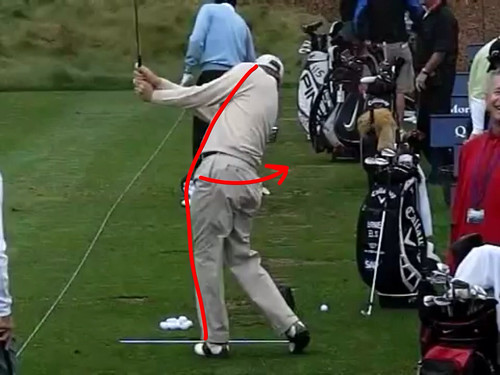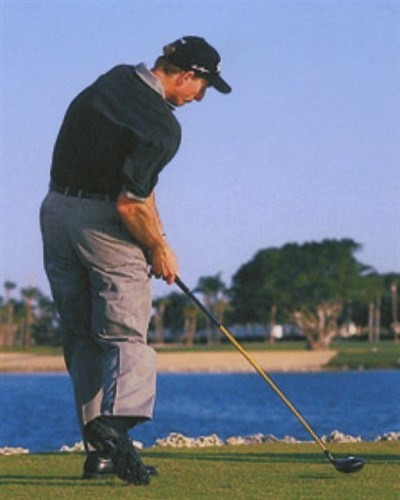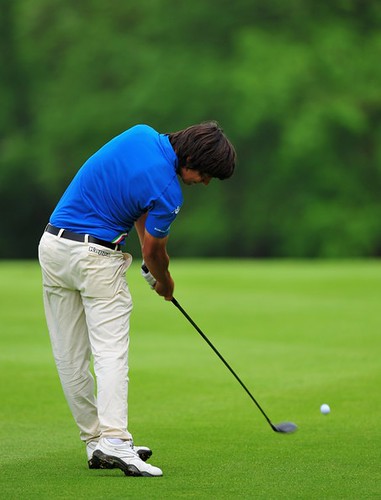 |
| Knee position at the top. |
We often hear that the downswing starts "from the ground-up." And then, we invariably hear that this means we should focus on our hips, which inevitably leads to debates about hips rotating versus bumping, ad infinitum. Amateur golfers develop all sorts of bad habits as a result of this debate.
But if we're focused on "ground up" sequencing in the downswing, doesn't that mean that we should start with the feet? And then ankles? And then the knees? Followed by the hips?
The first thing you should feel in a "ground up" transition and downswing is increased pressure in your left foot, almost as if squishing water from a sponge under that foot. This all occurs while your back is still turned towards the target (see "Knee position at the top" image).
 |
| Knee position at impact. |
A few notable golf instructors and professionals have spoken or written about how weight should move in the feet. Some talk about "rolling the ankles" (which sounds painful). And a few have written about the knees' movement during the downswing. I'm proposing that you consider the lateral, "rotational" movement of the knees. Why? The knees are closer to "the ground," kinetically-speaking. And you don't have to worry over weight movement in the feet or twisting an ankle, as you haplessly try to figure out what rolling them means. It seems that, if you move your knees correctly to start the downswing (especially that right or back knee), the weight shifting sensed through the feet is correct, and the hips automatically, kinetically, perform the correct actions.
 |
| Knee position at finish. |
Here's a tidbit that is not offered openly by very many teaching professionals: The knees move laterally, linearly, and "rotationally." The rotational part is an important, elusive tenet and one you may not have heard elsewhere, but the knees face the target line at address (i.e., towards the viewer in face-on view and parallel to the target line in DTL view) and turn to roughly face the target prior to impact. It's an optical illusion, or simply a misunderstanding, that leads weekend golfers to believe the knees remain in their address orientations throughout the swing; and put into practice in this way, it's a large power leak.
Note the images accompanying this post of touring professional, Jeff Overton, hitting an 8-iron in the face-on view. Using a golf swing analysis app, I drew red circles over the address positions of Jeff's knee caps to demonstrate how the knees shift and "rotate" during the swing. At or approaching the top, you can see that the right knee doesn't really move from its address position, while the left knee moves slightly toward the right knee (pointing at the ball). At or approaching impact, both knees have shifted toward the target considerably, both knees are still quite bent, and they have "rotated" more towards the target. At or approaching the finish, both knees are now facing the target. The right knee is bent, and the left is mostly straight. The right knee, though facing the target, has replaced the address position of the left knee. Both knees are nearly touching.
You may be thinking that the knees don't really "rotate" or turn, biomechanically speaking, and you'd be right. What actually occurs is that the left or forward hip joint undergoes external rotation (moving from an internally rotated position at the top of the swing), which allows the inside of the left leg to face the target line and the left knee to go from facing the target line at address to facing the target at impact.
The right hip internally rotates so that the right knee folds inward towards the left knee; during this movement, the right foot rolls to the inside but remains roughly on the ground, lengthwise, until it's finally forced onto the toe by continuing rotation. Both the "right foot roll" and the right knee "folding inward" occur together as a result of the correct lower body movement. It's possible that this "right foot roll" is the origin of the "ankle rolling" advice.
Regardless of which knee you choose to focus on, either knee is making specific movements and can lead the other knee to follow properly. Now, what about the knees moving laterally and linearly? If you should prefer thinking of the left knee: The bent left knee should move--laterally--out over the left foot (maybe even fractionally outside the left shoulder), separating itself from the right knee, causing the infamous "squat" look that Sam Snead made famous. It's also at this time when the left knee "rotates" to face the target, because the left hip externally rotates. This movement of the left knee forward begins WHILE the club is still setting at the top, which enhances lag on the way down.
The linear part of the movement really refers to the action of both knees. After the initial separation and lateral movement of the left knee, the right knee follows along the same line traveled first by the left knee; it appears to tuck in behind the left knee's address position when viewed down-the-line.
Not all pro golfers utilize a separated knee action and its pronounced squat move. But all of them have knees that move toward the target prior to impact and "rotate" to face the target.
Now to make a powerful transition in your golf swing from your backswing to your downswing you should transfer your weight from your back foot to your front foot.
A great way I have found to do this is to initiate the downswing by moving the front knee towards the target.
However, it’s a good idea when doing this to try and keep the back knee where it was in the backswing because this knee separation creates lag in the downswing, which helps to create the late hit that every golfer wants because it gives longer golf drives!
The Golf Swing: What Your Legs Should Be Doing To Hit Longer Golf Drives
If you're having trouble keeping your swing consistent when a match is on the line, key on your left knee to start your downswing. When you practice, remember to support your backswing with your right leg, then move your left knee and thigh laterally, then rotationally, to your left. This allows your arms to drop the club inside the target line on the downswing for long and consistent shots.
Even as the wrists are completing their part of the turn, the lower body has moved into the backstretch. The left knee moves laterally into the downswing and pulls on the left hip which in turn pulls the left arm downward. At the same time, the right knee begins to drive toward the target, taking with it the shoulders, arms, and hands.
When you execute the swing properly, the leadership of the legs creates a lag of the hands and clubhead, resulting in what's commonly called a delayed release. In this position, just prior to impact, the wrists have not yet uncocked and there is a tremendous amount of club head speed ready to be unleashed.
Instruction Tip #50 - The Downswing | The Shark
Jim Furyk won the Tour Championship and the Fedex Cup in 2010—thanks to his left knee. As we show in this video, the most consistent winners in the history of golf also started their downswing with their left knee. This made them consistent winners because it helped to insure that their downswing sequence was in the right order and that their front spine angle remained fairly constant.
Furyk Wins $11.35 Million with Left Knee
Sequencing Drill: Place and hold a clubshaft behind your back just above the shoulder blades and a soccer ball between your knees, and assume your address position. Just before your shoulders reach the top, drop the soccer ball by moving your left knee toward the target. This move will produce the feeling of a correct transition and a "sitting-down" look in your lower body.
Automatic Transition
The idea is to make your backswing move, then get a real sense of 'squatting' and 'settling' in the lower body as you fuse the two halves together by reversing momentum from the ground up. Your weight shifts back across to the left foot, left knee working towards the target while left hip and left shoulder pull in that same direction. The result is a natural shallowing of the swing plane as the right arm and shoulder drop, setting up the desired inside attack on the ball.
To do this the legs start by shifting both knees and ankles targetward. It is true that the head stays behind the ball, but the core of the body shifts and clears past the ball rather dramatically. This assists the hands and arms in making their initial drop to the waist high area while wrists are still fully hinged. At this stage the right wrist should still be bent back fully but the palm is now facing the ground not the sky. With the palm facing down this insures the clubface is also facing down or toward the ball and requires no scooping or manipulation to be squared up in time for the hit.
Golf Lag: Stop Casting, Lag like Tiger Woods
Use this image to check your weight transfer: Your right knee should point at or slightly in front of the ball at impact. That shows you've made a good shift. Here's the sequence: Left knee points behind the ball at the top; right knee points toward it at impact (above).
Tom Watson: Right Knee Power Key
As I transition my weight from my right side to my left side, I begin the necessary move of the right knee toward my left knee. You can see that happening here as I drop the club on the downswing and rotate my hips open. As the right knee gets closer to the left knee, the left knee straightens out.








